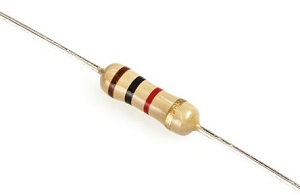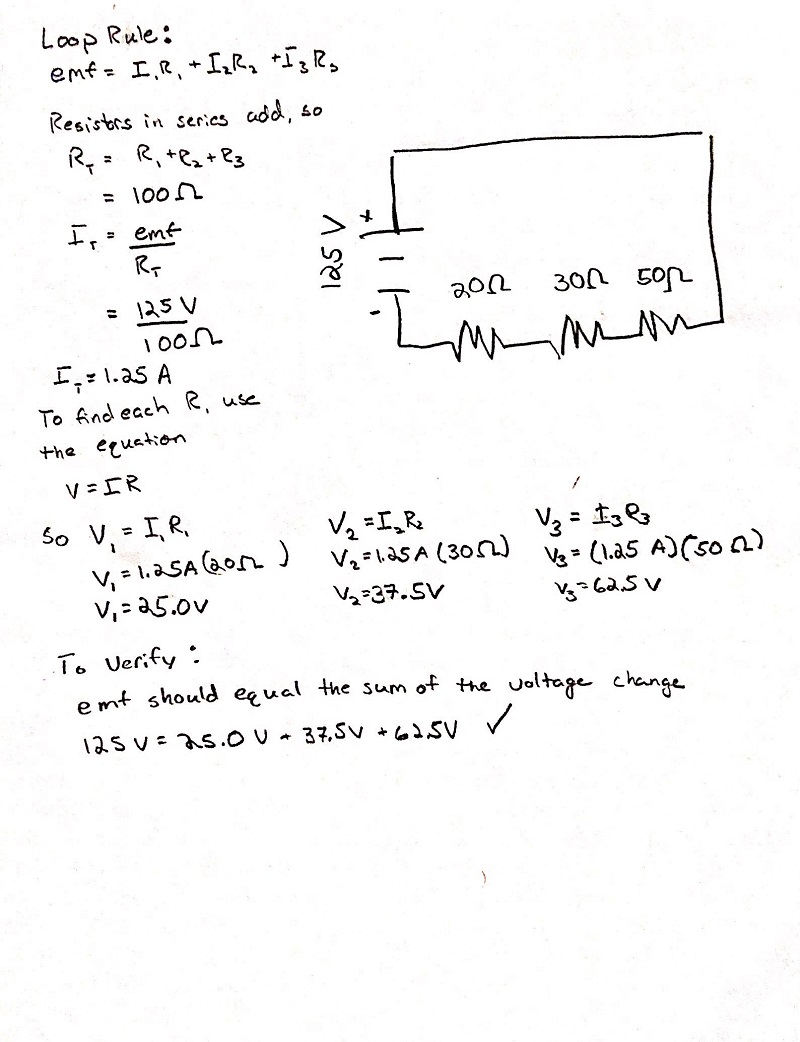R Circuit
Claimed by Matthew Munns - Fall 2017
Resistors may exist in a circuit and resist electric charge. The resistance of a resistor depends on the properties of the material and the area of the resistor. These two attributes will be investigated later in the page.
Resistors may be ohmic or non-ohmic. An ohmic resistor has a conductivity that is nearly constant, while a non-ohmic resistor will vary depending on the conditions. This page will focus on ohmic resistors in a complex circuit.
The following is an image of an ohmic resistor like the resistor used in lab:

History
Georg Simon Ohm, born in 1789, discovered Ohm's law. This law relates the current, voltage, and resistance across a resistor. His law was widely accepted by 1850. Ohm's law became the fundamental law in circuit analysis. In 1959, inventor Otis Boykin filed a patent for a resistor that allows manufacturers to designate a value of resistance for a piece of wire in equipment. In 1962, he patented an improved version, which could withstand more extreme conditions. This reduced the cost and increased the reliability of a variety of electronic products. [1]
Mathematics
As discussed above, resistance of a material is dependent on two factors: the properties of the material, and the area of the resistor.
From the above factors, we get the following definition of resistance: [math]\displaystyle{ R = \frac{L}{σ A} }[/math]
In this definition [math]\displaystyle{ L }[/math] is the length of the resistor, [math]\displaystyle{ A }[/math] is the cross-sectional area of the resistor, and [math]\displaystyle{ σ }[/math] is the conductivity of the material. [math]\displaystyle{ σ }[/math] can be further broken down to show [math]\displaystyle{ σ = |q|nu }[/math].
In A Circuit
There is a change in potential energy across a resistor, which is useful when evaluating the loop rule in a circuit with resistors. The change in potential across a resistor is [math]\displaystyle{ I = \frac{ΔV}{R} }[/math] Knowing this equation allows one to solve for [math]\displaystyle{ ΔV }[/math] if given [math]\displaystyle{ I }[/math] and either [math]\displaystyle{ R }[/math] or the components of [math]\displaystyle{ R }[/math] enumerated above.
In the case of a circuit resistors, the loop rule might look something like: [math]\displaystyle{ |emf| = I_{1}R_{1} + I_{2}R_{2} }[/math]
Equations Derived
From the definition of resistance and the voltage potential formula discussed above, a number of useful equations can be derived and solved. The first equation is [math]\displaystyle{ v = uE }[/math] where [math]\displaystyle{ E }[/math] is electron field , [math]\displaystyle{ u }[/math] as electron mobility, and [math]\displaystyle{ v }[/math] is drift speed.
This equation offers insight into the microscopic view of the resistor.
The second equation that can be derived is [math]\displaystyle{ I = |q|nAv }[/math]. This equation can be used, in addition to the above equation [math]\displaystyle{ I = \frac{ΔV}{R} }[/math] to solve for macroscopic properties of the resistor.
Example Problems
Easy Example
Question:
Use the loop rule to calculate the voltage drop across each resistor. Then ensure that your answer is correct.

Answer:
Difficult Example
https://www.youtube.com/watch?v=BW7U_5BtH-8
Applications
1.How is this topic connected to something that you are interested in? I am very interested in computers and I know that circuitry is the foundation of computers and other electronic equipment.
2.How is it connected to your major? My major is Industrial Engineering, and although I won't study resistors directly in any of my classes, I understand that resistors are crucial in the creation of the tools all engineers and scientists use such as computers and calculators.
3.Is there an interesting industrial application? As stated above, resistors are widely used in electric circuits. They are used to reduce current flow, change signal levels, and terminate transmission.
